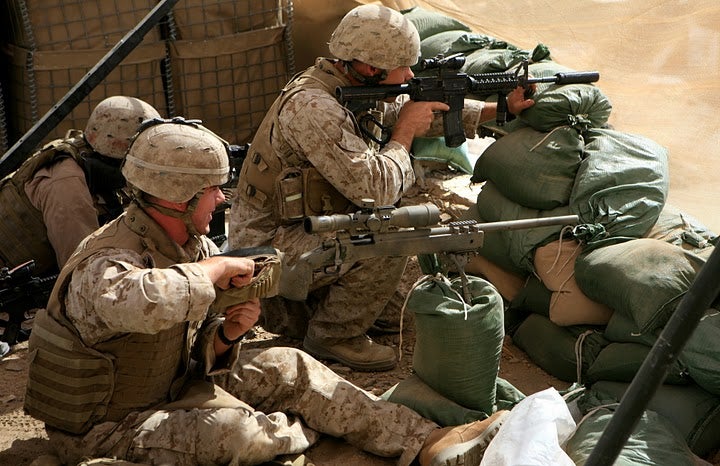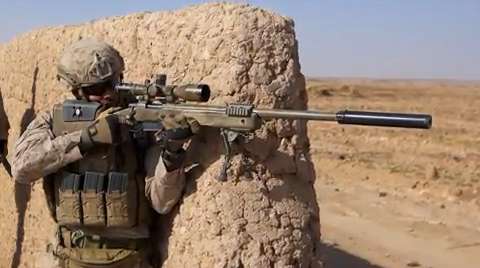Analysis- Scout Sniper Basic Course Failure Rate Part Two
Note-This post is a continuation of the earlier post that began, talking about some of the issues that are inherent with chopping the current Scout Sniper Basic Course in two. To read part one, please click here.
Back to the supply and demand. Who are you going to send? The Boot that just checked in? Or the salt dog PIG who has been in the platoon and has been training for months for this opportunity. You’re going to send the PIG, hands down.
Now we’re back to the timing issue, except we have less time. Remember that 15 months of operational training? That number just got cut in half, down to 8 because we’re being gracious. The number got cut in half because the first half was the time it took that Boot to get sped up on knowledge and training. In addition, maybe he wasn’t even in the platoon during that 8 months because he was in a line company on his first deployment and only joined the platoon afterward. The overwhelming majority of Marines from Sniper platoons that get sent to school usually have one deployment under their belt already, for the reasons discussed above.
We are at 8 months to complete a 3-month course. 79 days is 2.6 months but I’m assuming that since the course is cut into two, it’ll be longer on both ends due to gear turn in/issue, we also have to take into account injuries sustained. How much of that 8 month period is the platoon’s probationary period after passing an Indoc, is taking place for that Marine? How much of it is speeding him up on knowledge and going on field ops to practice that knowledge? How much of it is spent at a preparatory course to get him ready?
When I went to the Basic Course, there were four Marines before me that went from my platoon, and three afterward. Of those eight, three failed and didn’t return (myself included) while two failed and did return to complete the class. Granted, one of the failures joined the class at a later portion. But if we translate that to this new program. Say you go for 1.5 months, fail for Land Nav, then go back, and pass it. Now you’re at the 3-month mark of time of your 8, down to 5. You can make exactly two attempts at this course before your platoon probably won’t send you back again because now you’re pretty much only got 2 months left of training time (5-3). That is cutting awfully close to getting ready for the unit’s work up for the next deployment.
My point throughout this analytical exercise is that although the two part course might seem like a good idea, when it is confronted with reality, I don’t know if it will hold up, purely based on the amount of time that enlisted Infantry Marines are dealing with. Of course, I should add that Marines can extend their contract because of the Basic Course. But this decision varies from Marine to Marine, not all Infantrymen want to hate life several months more than they have to.
The other point I want to get across is that the battalion these platoons belong to has priorities. Having a T/O platoon of School trained Snipers would be excellent, but having a full complement of MRAP and MAT-V drivers, UAV operators, even sending Marines out to radio courses might override whatever capability school trained snipers would give to the battalion. Another thing is that the battalion pays for all this through the training budget. Whether a Marine passes or fails, it doesn’t matter to the training officer that sees valuable dollars being eaten up by Marines that are continually being sent back to a school that appears to be teaching antiquated techniques that haven’t been actively used against the enemy since Vietnam (in the officer’s mind).
The Experience Issue
I mentioned earlier the difference between the newer Boots, and the guys already in the Sniper platoon, the PIGs, or Professionally Instructed Gunmen. These are Marines that are in the platoon, most likely have deployed overseas, but aren’t snipers. They carry ammunition, act as spotters, provide security, and work medical issues. The overwhelming majority of Fleet Marines that get sent to the Basic Course are these PIGs. Usually PIGs are much more mature, better trained and smarter than the Boots that are checking in. In addition, the PIGs have earned a sort of seniority in waiting for their place in line to go to school. Unlike being in a line company, being a PIG in a Sniper platoon is never certain. If you slack off, you get kicked out of the platoon, back to the line companies (this is what happened to me). Boots that come into the platoon might not all make it through a deployment as they are sometimes found out to be unworkable and get kicked out.
The problem with the answer the Marine Corps has to the issue with this two course system is that it isn’t conducive to the actual Marines that will be going to the school house, the PIGs. I mentioned earlier that these guys are usually two years into their Marine careers after a deployment, and thus have limited time left in service for which to gain more experience between school house courses. I could see this two part course theme working with Boots who came directly into the platoons after their Indocs, but as I mentioned earlier usually platoons don’t want to send these guys in the first place because of the PIGs that already exist in the platoon. After a deployment, if a Boot has proven his worth, then of course he could be sent, but again we run into the timing issue because this puts him on the same timeline as those PIGs that I talked about earlier (of course by this point, the Boot is no longer a Boot).
The MOS Issue
One of the largest problems apart from failing school in the Scout Sniper community is that the Military Occupational Specialty of Scout Sniper, 0317, is a secondary MOS and not a primary one. What this means is that there is very little career advancement or opportunities available for 0317s. They can either become instructors at the school house, or they can advance positions within sniper platoons up to platoon sergeant. Some go on to teach the Recon Marines at their school house. But in the end, there isn’t a complete career solution for these Marines as there is with other MOS’s. As an example, if you’re an 0311, you can go on to being a Combat Instructor at MCT or SOI, afterwards you can become an 0369, an Infantry platoon sergeant, then maybe you can advance in the ranks to being a Gunny or even Sergeant Major and retire from there. With 0317s there is a cap, at which you have to put down the Scout Sniper card, and then go back to doing 0311 or 0369 work until your retirement from there. The problem with this system is that the community for those in Scout Sniper platoons is extremely small, and thus the knowledge base and training is also very small. Thus it’s much harder to train up a PIG for Sniper school than it is to train up an 0311 for advanced squad leader’s course, or an 0331 for advanced machine gunners. This gap becomes obvious because so many Marines are failing out of school whereas if they had a much larger and deeper career field to invest in, it might be easier to groom and train them for success.
The solution?
Right now the best solution from the community is to have prep schools for those PIGs going to the division school. These usually last several weeks after which PIGs get sent straight to school. The success rate of Marines going through these prep schools is much higher than PIGs that get sent straight to the school house. Usually these prep schools are put together on an informal basis between different sniper platoons working together. The problem is that finding the training time and funds to go through with this can be quite difficult. Trying to get multiple battalions to work together is almost impossible because each battalion has its own training regime and schedule that it has to adhere and stick to. However in the Marine Corps budget eyes, it appears that it is far less costly to split the course in two, than to provide additional funds for a prep course that would really prepare PIGs for their school house. On this note I’d like to point out that the SEAL program was suffering a similar failure rate and went the same route of the prep course. This resulted in more SEALs being turned out at the BUDs course, but only because most of the guys that were quitting in the prep course were guys that guys that would have dropped out of the BUDs course anyways.



